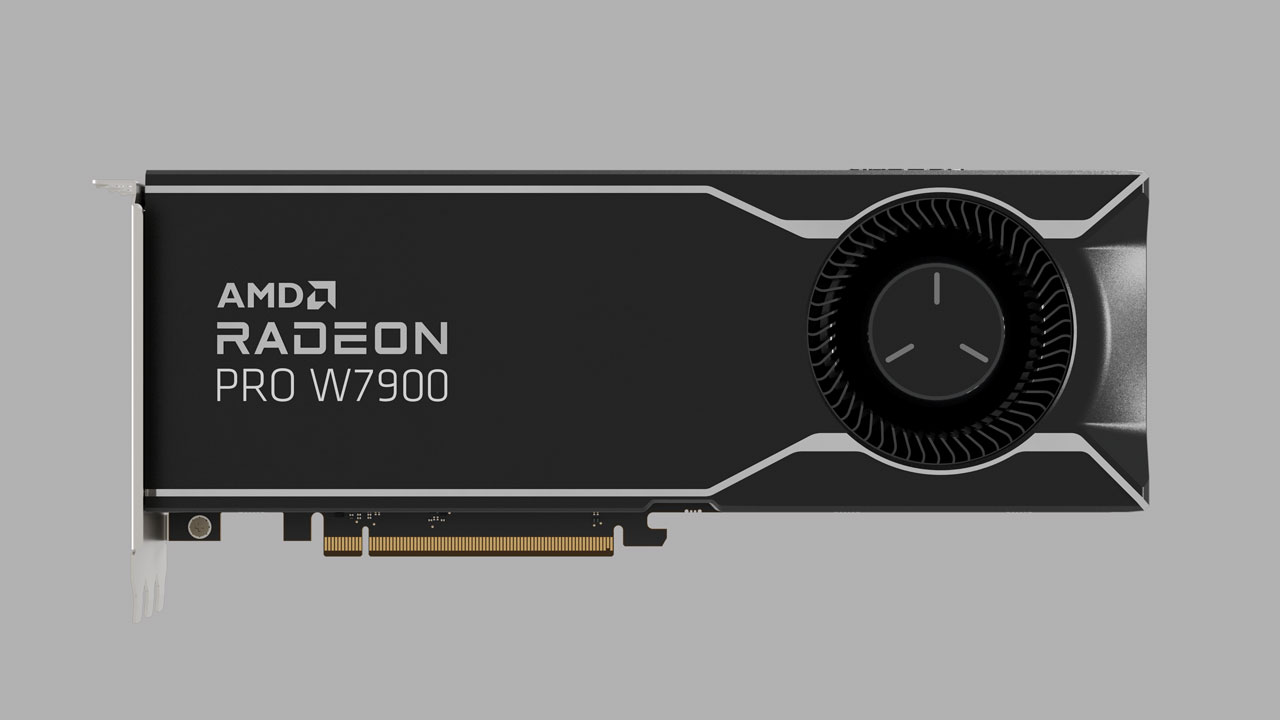AMD just announced the Radeon PRO W7000 Series graphics family, its most-powerful workstation graphics cards to date. Spearheads are the Radeon PRO W7900 and AMD Radeon PRO W7800 graphics cards – built on groundbreaking AMD RDNA 3 architecture.
The new graphics cards are designed for professionals to create and work with high-polygon count models seamlessly, deliver incredible image fidelity and color accuracy, and run graphics and compute-based applications concurrently without disruption to workflows.
AMD Radeon PRO W7000 Series graphics cards feature the world’s first workstation GPU architecture based on AMD’s advanced chiplet design, providing real-world multi-tasking performance and incredible power efficiency. The new graphics cards are also the first professional workstation GPUs to offer the new AMD Radiance Display Engine featuring DisplayPort 2.1 that delivers a superior visual experience, higher resolutions and more available colors than ever before.
The AMD Radeon PRO W7900 graphics card, designed for extreme workloads, features 61 TFLOPS (FP32) peak single precision performance, offering 1.5X higher geomean performance on the SPECviewperf 2020 benchmark. It also includes 48GB of GDDR6 memory, which is 1.5X larger memory capacity than the 32GB available on the previous-generation graphics card. Created for heavy workloads, the AMD Radeon PRO W7800 graphics card features 45 TFLOPS (FP32) peak single precision performance and 32GB of GDDR6 memory.
“The new AMD Radeon PRO W7000 Series are the most powerful graphics cards AMD has built to date, providing professionals, creators and artists with exceptional performance and value to drive the most demanding professional design and creative applications,” said Scott Herkelman, senior vice president and general manager, Graphics Business Unit at AMD.
AMD Radeon PRO W7000 Series workstation graphics cards are designed to help professionals meet high-pressure deadlines under increasingly tight budgets while delivering world-class results. Key features include:
- AMD RDNA 3 Architecture – New compute units share resources between rendering, AI, and raytracing to make the most effective use of each transistor, offering approximately 50% more raytracing performance per compute unit than the previous generation. AMD RDNA 3 architecture also features optimizations for AEC, D&M, and M&E workflows for rendering, video editing, and multitasking.
- Advanced Chiplet Design – The world’s first workstation GPUs with a chiplet design provide higher performance and greater efficiency than the previous generation. It includes the new 5nm Graphics Compute Die (GCD) that provides the core GPU functionality. It also includes six new 6nm Memory Cache Die (MCD), each with second-generation AMD Infinity Cache technology.
- Dedicated AI Acceleration and Second-Generation Raytracing – New AI instructions and increased AI throughput deliver over 2X more performance than the previous AMD RDNA 2 architecture, while second-generation raytracing technology delivers significantly higher performance than the previous generation.
- Up To 48 GDDR6 Memory – Allows professionals and creators to work with the largest 3D models and environments, edit and layer complex timelines using the latest digital cinema cameras formats and render photorealistic, raytraced images with unparalleled quality. Professional applications that can take advantage of the larger framebuffer include Adobe Premiere Pro & After Effects, Autodesk 3ds Max & Maya, Blender, Boris FX Sapphire, Dassault Systèmes SOLIDWORKS Visualize, DaVinci Resolve, Lumion, Maxon Redshift, and many more.
- AMD Radiance Display Engine with DisplayPort 2.1 – Supports the highest resolutions and over 68 billion colors and offers support for higher refresh rate displays compared to AMD RDNA 2 architecture and current competitive offerings. Display outputs support next-generation displays and multi-monitor configuration options, creating an ultra-immersive visual environment.
- AV1 Encode/Decode – Dual encode/decode media engines unlock new multi-media experiences with full AV1 encode/decode support designed for high resolutions, wide color gamut, and high-dynamic range enhancements.
- Exceptional Workstation Performance – The AMD Radeon PRO W7000 Series graphics cards compliment the AMD Ryzen Threadripper PRO processors by providing the horsepower necessary to handle demanding creative, production and visualization workloads quickly and efficiently. AMD Radeon PRO Series workstation graphics and Ryzen Threadripper PRO processors provide exceptional performance, reliability, and stability to power mission-critical professional applications.
- Optimized Driver Performance – All AMD Radeon PRO workstation graphics are supported by AMD Software: PRO Edition, which provides a modern and intuitive user interface. Radeon PRO Image Boost renders visuals higher than a display’s native resolution to optimize image quality and resolution, while Radeon PRO Viewport Boost dynamically adjusts viewport resolution, boosting framerates and navigation performance in select applications.
- Certified for leading professional applications – AMD continues to work with leading professional software application vendors on a comprehensive application certification program, and to ensure AMD Radeon PRO graphics cards are built for demanding 24/7 environments and tested to meet exceptional standards, delivering the ideal balance of performance and stability.
Product Specifications
| Model | Compute Units | TFLOPS | VRAM | Memory Bandwidth/Interface | Display Outputs | TBP |
|---|---|---|---|---|---|---|
| AMD Radeon PRO W7900 | 96 | 61 (FP32) | 48GB GDDR6 ECC | 864 GBps/384-bit | 3x DP 2.1, 1x mini-DP 2.1 | 295 W |
| AMD Radeon PRO W7800 | 70 | 45 (FP32) | 32GB GDDR6 ECC | 576 GBps/256-bit | 3x DP 2.1, 1x Mini-DP 2.1 | 260 W |
Price and Availability
The AMD Radeon PRO W7900 features an SEP of $3,999 USD. The AMD Radeon PRO W7800 features an SEP of $2,499 USD. The AMD Radeon PRO W7000 Series workstation graphics cards are expected to be available from leading etailers/retailers starting in Q2, 2023. Product availability in OEM and SI systems is expected in 2H 2023.
